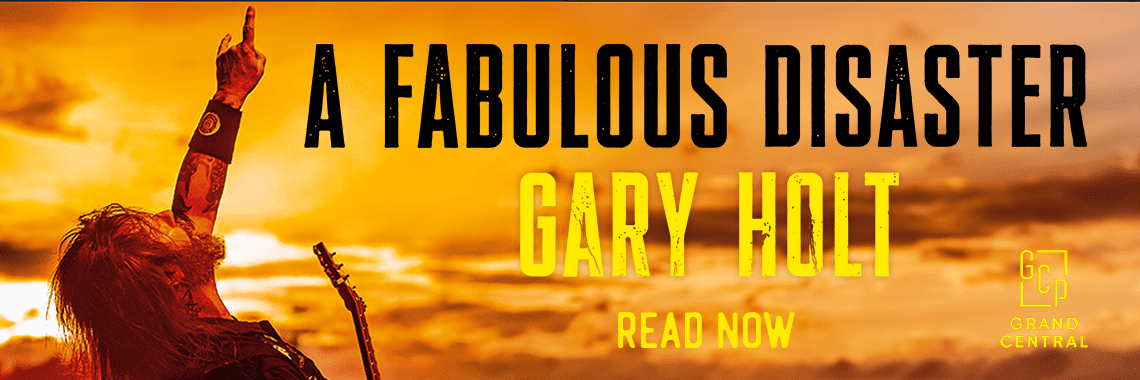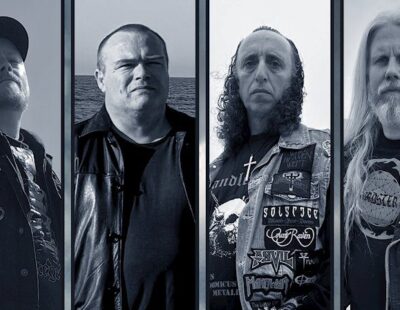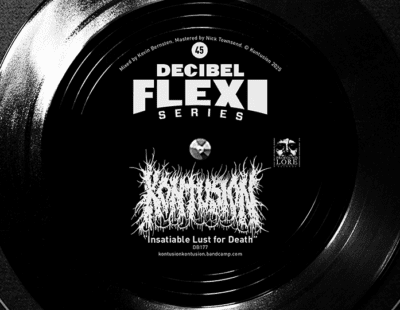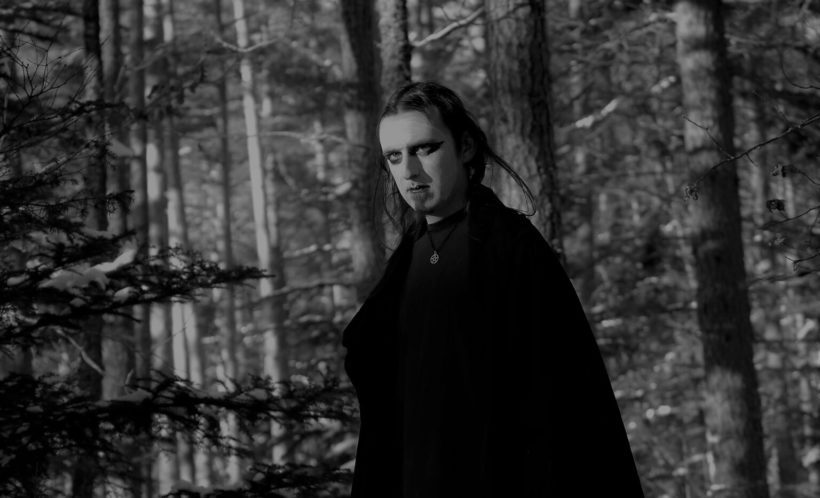
In the universe of one-man black metal acts, France’s Esoctrilihum, conceived and realized by visionary Asthâghul, stands alone. Over the course of four years, Asthâghul has built an empire of his own design, releasing six full-lengths via Italian independent I, Voidhanger. Asthâghul’s latest long-form stunner is the tongue-twister Dy’th Requiem for the Serpent Telepath. While Esoctrilihum–a magically-derived word–has peers in bands as diverse as Blut aus Nord, Ævangelist, Chaos Moon, and The Ruins of Beverast, there’s truly no comparison.
Sonically, Esoctrilihum have morphed since debut long-player Mystic Echo from a Funeral Dimension (2017). Asthâghul’s songs are more realized, offering new horrifying views into his personal hellscape of monsters, demons, and antagonists. From the artwork–check out the Dhomth and Alan E. Brown pieces for Dy’th Requiem for the Serpent Telepath and Eternity of Shaog (2020)–and physical layout (CDs come in an A5 digipak) to songs like “Salhn,” “Eginbaal,” “Ezkikur,” and “Nominès Haàr,” Esoctrilihum have dialed a very captivating, if tormented scape. Someone recently described Dy’th Requiem for the Serpent Telepath as singular, nightmarish version of Edge of Sanity’s Crimson, Portal’s Outre’, and My Dying Bride’s Symphonaire Infernus et Spera Empyrium.
Read on as Decibel reaches into Asthâghul’s intramural palace of pandemonium.
How did you get involved in extreme music like death and black metal? What were some of your gateway bands or experiences?
Asthâghul: I was never involved in any metal band before Esoctrilihum. I always preferred to compose alone. I will say that I never wanted to play with other human beings, so we cannot certify that it was the others who involved me in this universe. My own experiences have accumulated over time. I was mainly drawn to this music because darkness has always fascinated me, and musical sadism is delectable, so black art came naturally to me. The music we listen to clearly reflects our thoughts, and our impulses, so for me dark music is a continuation of my actions in this world. If I had to name a few names that brought me to black music it would be: Limbonic Art, Absu, Necromantia, Setherial, Nokturnal Mortum, Ragnarok, Graveland, Gorgoroth, etc. I was able to achieve my first musical experiences by composing a certain number of melodies. I subsequently highlighted these melodies by accompanying them with programmed drums. But since I’m a drummer, I still wanted to develop my personal patterns on the album Telluric Ashes… by playing most of the songs with an non-programmed drums. It was by discovering the different studio tools that I was able to shape my own sound, and accumulate my different experiences.
Esoctrilihum is an interesting name. I gather it’s not an actual word but made-up to fit your personal, spiritual, and musical aesthetic. Can you illuminate Decibel readers on the origins of the band name? And how does one pronounce it, “e-sock-trill-e-hoom”?
Asthâghul: Yes, absolutely. Esoctrilihum is a totally made up name. To be honest, this name came to me rather abruptly, because before I even started to compose anything, this chain of letters came to my mind. We can directly refer to the word “esoteric”. Certain words are the vector of an occult force; this aspect evokes the direction in which I want to go, because the name of an entity must represent the essence of an artistic project. The origin of the name is also based on a lexicon that I invented, but I would like to keep the origin of this language secret. Esoctrilihum constitutes a special meaning. Could this be the name of a hidden monarchy of demons? Or, to refer to a psychotropic substance allowing [me] to reach a very particular psychic state which would open the door to beings coming from elsewhere? I leave people’s imaginations to make their own choices regarding the origin of the name Esoctrilihum. Indeed, we can pronounce this: “e-sock-trill-e-hom”.
Many have troubles describing your music. How do you view the music you create from a strictly musical perspective?
Asthâghul: I don’t know if I am in the best position to describe my music. But from a strictly musical point of view, I would say that I relate more to experimental metal, or avant-garde metal. I’m not trying to orient myself towards a particular style. What I try to invoke in my music is very personal, and that’s why my subconscious looks for inspiration in a lot of different areas. So for me it is very difficult to put Esoctrilihum in a particular box.
Is the music creation process more of a spiritual outlet than a creative one? Meaning, the impetus is from your religious preferences than writing from a proverbial “blank slate”?
Asthâghul: Well, it’s a spiritual and creative outlet. I actually mix the two together. My spiritual preferences are involved in my creative process, these two aspects are linked, because concerning myself, I cannot create art without putting part of my occult practices into it. I personally see that art in general is so much more attractive when there is a mysterious, mystical, or even esoteric side to it. But most of the time, I write and compose from my beliefs in curious things. I created names and seals relating to demons, in a kind of demonic tree. The mythology of Esoctrilihum is based on this. There are invisible beings that manifest when we give them a name, we can, as a human being, name these invisible energies and interact with them, and that’s what I’m trying to do with my musical project. I try to attract particular entities with my own rituals. If we think carefully, there is also a literary author who tried to do the same thing with a very well-known book, and who understood what I am trying to understand too. In addition, certain frequencies can also bring beings invisible to us.
Asthâghul: I never thought about it. But to others, it might seem incredible to make all this music yourself. But, each has their own unique abilities. This is why in my opinion, we must discover our hidden competences. Take the example of extra-sensory gifts, some deny the existence of these things. We just have to learn to control that part of us, everyone is capable of that, but I agree that there is some difficulty in reaching a certain level of consciousness. A few people think that we can get to do specific things through the medium of a celestial or demonic power, I also agree, but you should know that a lot of things are accessible to us only through the intermediary of our mind, we can unlock a lot of things by natural processes, but there is also the other side… Yes, Esoctrilihum would not work properly if I shared my energy with other people. Only loneliness allows me to accomplish my misdeeds!
What do you see as separating/relating elements between previous album Eternity of Shaog and new album, Dy’th Requiem for the Serpent Telepath?
Asthâghul: Eternity Of Shaog and Dy’th Requiem… are two different albums, but they follow each other musically speaking; there are elements of a “symphonic” nature. This is an aspect that I like to work a lot, I wanted to incorporate these “symphonic” parts because it clearly evokes an imaginary world and at the same time mystical and epic. I can not really describe in words my feelings, but there is a very powerful vector in this kind of orientation. Otherwise, for Dy’th Requiem…, I preferred to give a more “doomy” direction, because I actually wanted there to be more pain in the key of certain songs. The difference is also in my state of mind, for Dy’th Requiem… I wanted to spit out all my deepest and most sadistic obsessions, which was not the case in Eternity Of Shaog. With this new album, I was able to prevent myself from committing horrors in life, even if my instability pushes me to do things that I do not want, this album has helped me a lot, but in the future I plan to create other albums that will prevent me from going completely insane.
Dy’th Requiem for the Serpent Telepath is over an hour long. Are there songs that speak to you more than others? I really gravitate towards the doom-death sounds of “Ekikur”, “Agakuh”, and “Salhn”. So haunting in that early ‘90s UK/Euro style.
Asthâghul: Regarding my works, there is none that speaks to me more, each song is built on particular emotions, so each song has a specific importance in the balance of the album. However, despite my previous comments, if I had to choose some examples, there is one that is dear to me, it is “Eginbaal.” The melody at the end of this song brings together very distinct shapes and thoughts that I had in me for a long time; I had to expel that. But indeed in “Agakuh,” there is also a portal. In this song, I exercised my faculties to create a symphony, and my themes are adapted to these waves. Another detail, in “Tyurh,” I incorporated during a passage, violins which take a very special turn, we could associate them with something else. There is also “Baahl Duthr,” where I developed my clear vocals, and “Xuiotg,” in which we can estimate that this kind of song will be the beginning of something more violent. There are obviously “Salhn” and “Ezkikur,” which have a very “doomy” orientation.
Walk us through your titling process. How are words and themes constructed? They look and sound occult-derived or inspired.
Asthâghul: To create a title, or themes, I use the names of demons or entities from various beliefs. I add to that, my own words, from a secret language. I also consulted a lot of ancient and esoteric works in order to have more concrete references. But I still say, that I definitely prefer to create my own cabal, with its own mythologies. In my opinion, it is much more interesting to imagine a parallel world rather than based on an already preexisting concept. But we must not forget either, that each universe is only the pale reflection of a much more macabre reality, everything that we create relates in some way to a whole, which is in each of us. The occult virtues of things are present everywhere! Similarities can be found in many esoteric concepts, just as occult traditions resemble each other from a certain point of view. There is one truth that never betrays seekers of darkness.
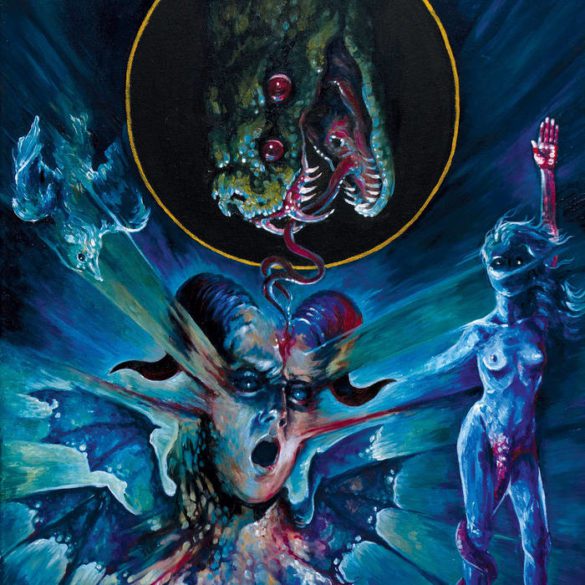
What are some of the themes or lyrical landscapes you’re taking listeners on throughout Dy’th Requiem for the Serpent Telepath? The letter combinations feel very ancient Levant, like you’re co-mingling words/phrases from Sumerian, Nesite, and Syriac. Maybe there’s even Sanskrit woven into your titles/motifs, too.
Asthâghul: The themes are very personal, even more personal than Eternity of Shaog. For Dy’th Requiem…, I relied on my obsessions, and the rebirth of the Great Serpent Telepath. I evoke the torments of an entity which, hidden for millennia, takes the appearance of several forms, and several names to communicate with humans. He manifests himself by catching souls in his doctrines, and He takes possession of beings, to commit atrocities under the influence of the great black demon. It is a grim view of the magnificence of evil. Darkness is the basis of life. We must glorify this blackness, and pay homage to it by practicing a cursed requiem until the end of the promised times. Taking care of a lifeless body, and infusing it with the elegance of putrefaction, is very beautiful. Obsession can lead to excruciating deeds, and literally can slowly destroy a man, but it also means great inspiration to create black art. But, I’m in a situation where my life is nothing but a hell I could never get out of, my secret obsessions and instability doom me under the thumb of whoever reigns behind the veil, and I take advantage of this situation to create music. The world is literally destroying itself, and as long as the forces of the Great Serpent act, the darkness will endure, but time is running out, soon this world will be cleansed of all filth, but I have already chosen my side, and the black forces will support me to my grave, is this an advantage, or a curse? The great millennium will begin in no time.
On previous albums, Alan E. Brown illustrated some incredible pieces to be used under the Esoctrilihum banner. Why the change in illustrator for Dy’th Requiem for the Serpent Telepath?
Asthâghul: Regarding the artistic choices about the cover, it’s Luciano, (I, Voidhanger Records), who manages this. Usually he shows me the artwork, and then we advise. The universe of Dhomth corresponds to the new album, and I appreciated all the symbolism that we find on the painting. And moreover, I can directly refer to the serpent which corresponds to the great Telepath, and the demon in the middle which corresponds to Zhaïc. So for me this choice of painting is perfect and corresponds to my universe. I think that’s also why we decided to change painter.
Dhomth has created quite an impressive cover, however. The blue hues, the double-eyed snake, the red-colored arm/hand, and the wo-man appear rife with religious and cultural symbolism. How involved were you in the creation of the painting?
Asthâghul: Yes, the painting that Dhomth created is amazing. I appreciate it a lot, because indeed, there is a lot of symbolism behind this painting, and I prefer that each listener make up their own mind about the history of this artwork. However, I was not involved in the creation of the painting. As said before, my label shows me what it finds, and then I choose whether or not the painting suits me. But I have already linked the different aspects of the work in relation to my own mythology, and I think that if this painting worked so well, it is because it lends itself well to my world. I know I said it before on another interview, but I’m repeating myself here. Zhaïc, is an entity that I created, he is an infernal duke who commands 72 legions of spirits. It takes the form of a specter moving with the help of dragon wings. He transmits the power to read the minds of others, and to hurt others. To submit to its influence, you have to mutilate yourself and offer precious stones! It’s a ceremony of suffering, and an ode to sadness, everyone cuts their arms, torso and face… And concerning the telepathic serpent, I prefer to keep secret its meaning, and its full name.
Dy’th Requiem for the Serpent Telepath is a fantastic piece of work. It’s daunting due to its opaqueness, complexity, and length, but there’s something that draws people into it. A gravitas that is similar to your previous work.
Asthâghul: I think the themes, and the “drama” aspect shaped something much more consistent. It’s also not for nothing that I decided to take a more symphonic and perhaps more epic approach. This is mainly so that the listeners understand that there is something going on in the background, something terrible, strange and significant. I won’t be able to say exactly how my music attracts people, but I think that by letting some energy flow, things just happen by themselves.
What are your plans now that Dy’th Requiem for the Serpent Telepath has been released? More music next year?
Asthâghul: Exactly. Expect a lot more music, if all goes well. I still have a lot to get out of my mind before my project comes to a complete stop. Thank you for giving me the floor. I now want to thank the dark spirit who guides me and all the people who support me.
** Esoctrilihum’s new album, Dy’th Requiem for the Serpent Telepath, is out now on I, Voidhanger Records. 2xLP, A5 digibook CDs, and t-shirts are available now via the 8 Merch. Click HERE to order, or find yourself at the unmerciful command of the telepathic serpent.

